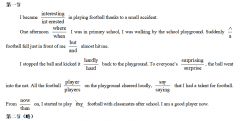2015黑龙江哈三中高三上学期第二次测试英语试题及答案(2)
A. gave a TED Talk recently
B. is captain of her swim team
C. has a large circle of friends
D. contributed to the cancer research
22. According to Bose’s research, ______ helps make Cisplatin work better.
A. stopping the protein from growing
B. destroying cancer cells timely
C. using the drug more frequently
D. making the protein react with the drug
23. From the passage, we know that _____.
A. Bose’s research was supported from the start
B. Bose plans to become a doctor in the future
C. Bose will study in the National Institute of Health
D. Bose’s grandfather asked her to do cancer research
24. The passage is mainly about _____.
A. a research on cancer drugs
B. a new effective cancer treatment
C. a doctor who has a promising future
D. a girl who did research on cancer treatment
B
A surprising new research suggests it can actually be good to feel bad at work, and that feeling good in the workplace can lead to negative outcomes.
The study of emotions in the workplace, edited by University of Liverpool researchers Dr. Lindebaum and Peter Jordan, is the topic of a Special Issue of the journal ‘Human Relations’. They found that the commonly-held belief that being positive in the workplace produces positive outcomes, while negative emotions lead to negative outcomes, may be in need for reconsideration. This is partly due to this belief failing to take into account the differences in working environment which affect outcomes.
For instance, anger does not always lead to negative outcomes and in some cases, anger can be considered a force for good through acting upon injustices. An employee, for example, could express anger constructively after a manager has treated a fellow worker unfairly. In such cases, anger can be useful. Likewise, being too positive in the workplace, rather than resulting in greater performance and productivity, can lead to self-satisfaction and being too shallow in one’s personality.
One article within the issue also finds that, within team work situation, negativity can have a good effect, leading to fewer consensuses (共识) but a further discussion or debate on an important issue among workers, which enhances team effectiveness.
Lindebaum said, “The findings of the study published in this Special Issue challenge the commonly-held belief that in the workplace positive emotions bring about a positive outcome, and vice versa.”
He added, “This Special Issue adds to our knowledge and understanding of how the positive and negative dynamics (动态) affect the working environment and is certain to have practical application in the workplace for the years to come.”
25. Why did researchers of the study of emotions find that the commonly-held belief needs to be considered again?
A. Because different people hold different attitudes towards it.
B. Because it doesn’t consider the differences in real working environment.
C. Because it has been proved to be totally wrong in real working environment.
D. Because it doesn’t tell the truth.
26. What does the underlined word “Likewise” in paragraph 3 probably mean?
A. Similarly B. Differently C. Approximately D. Occasionally
27. It can be inferred from what Lindebaum said in the last paragraph that ____.
A. the findings of the study will completely change people’s belief in the end
B. the findings of the study will not have any influence on the workplace
C. the findings of the study won’t be just a theory published in the journal
D. the findings of the study will make us work negatively in the future
28. What would be the best title for the passage?
A. To Be Positive About Your Work
B. To Be Negative About Your Work
C. Negativity at Work Probably Bringing About Good Things
D. People Challenging the Commonly-held Belief
C
Over the years, Brian Wansink, director of the Food and Brand Lab at Cornell University, has studied such things as how far Americans typically drive to buy food, how many times we refill our plates at all-you-can-eat buffets and how we organize our kitchens. In the mid-2000s he famously coined the phase “mindless eating”(and wrote a book by that name) to focus attention on all the bad dietary decisions we make without really thinking about them.
His new book, Slim by Design: Mindless Eating Solutions for Everyday Life, aims to change the design of restaurants, school lunchrooms, office cafeterias and homes so that the mindless choices we make will be more healthful ones. Some examples:
Keep kitchen counters clear. No visible snack food, no bread, no nuts — not even breakfast cereal. In Wansink’s research, “women who had even one box of breakfast cereal that was visible –- anywhere in their kitchen — weighed 21 pounds more than their neighbor who didn’t.”
Trick yourself into drinking less wine. “We tend to focus on the height of what we pour and not the width, so we pour 12 percent less wine into taller wineglasses than we pour into wider wineglasses.” And the shape of the glass is not the only variable that affects how much we drink. Wansink writes: “Because red wine is easier to see than white wine, we pour 9 percent less red wine whenever we pour a glass.”
Wansink said his researchers also found that people ate less at restaurants when they sat in well-lighted areas near windows and doors, than in darker areas or in the back. They ate less if they were offered a doggie bag, or to-go box, before they got their meals: apparently the idea of getting a “free” second meal outweighed (比……重要) the impulse (冲动) to clean their plates. Workers who frequently ate at their desks weighed 15.4 pounds less, on average, than those who didn’t. Fruits and vegetables kept on the top shelf of the refrigerator were eaten at higher rates than those on lower shelves.





